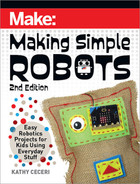
ROBOTS THAT
GET AROUND
#2
Explore robots that move in unusual ways
Cover Page “i”
Preface Intro Chap 1
Xxxxxx Chap 3
Chap 3 Chap 5 Chapter 2
Make_Simple_Robots_interior_FIN.indd 26Make_Simple_Robots_interior_FIN.indd 26 4/26/22 1:54 PM4/26/22 1:54 PM

One of the biggest robot design challenges is making them move from
place to place. Lots of robots are designed to walk, run, or jump the same
way people and animals do. The Walking Robot Dog in Chapter 1 had
four legs like a real dog — but robots with two, six, or even more legs are
common. Other robots look like vehicles and drive around using wheels like
cars or treads like tanks. Flying robotic drones are also popular. But robots
can use all kinds of weird ways to travel.
Maybe you’ve seen ball-shaped robots like BB-8, the helpful droid that rolls
around the Star Wars universe. In real life, an educational company called
Sphero makes rolling robots about the size of a billiard ball. You can tell
them where to go just like an RC car, using your smartphone as a remote
control.
Then there are robots that combine the best part of legs and wheels, with
legs that spin around like wheels. They’re known as whegs (the name is a
registered trademark of Case Western Reserve University in Cleveland),
and look like the spokes on a wagon wheel, without the rim. Whegs can
climb up stairs or step over bumpy terrain. On smooth ground, they can
simply roll along like regular wheels.
Other robots just shimmy and shake where
they want to go. Instead of legs swinging
back and forth or wheels spinning, they
use vibration motors to get from place to
place. If you’ve ever made a brush bot by
adding a tiny disk vibration motor to the
head of a toothbrush, or played around
with a Hexbug Nano toy robot, you know
those things can move fast. These are
examples of a programmable body
because, by pointing the brush bristle
“legs” one way or another, you can make
them head in a specific direction.
Sphero
Sphero, a robotic ball that can
be programmed to jump or roll
with a smartphone app, was the
pioneer of rolling robots.
Make_Simple_Robots_interior_FIN.indd 27Make_Simple_Robots_interior_FIN.indd 27 4/26/22 1:54 PM4/26/22 1:54 PM

Robots can also use their wiggly bodies to move. Tensegrity robots don’t
have a skeleton or any framework that holds everything together. Instead,
they consist of supports (called struts) that never touch. The struts are
connected to each other by tightly strung cords. This makes a tensegrity
really springy — when you squish one flat, it pops right back into shape.
Roboticist Vytas SunSpiral and others designed a tensegrity lander for
NASA called the Super Ball Bot. The idea was to create a space vehicle
that could bounce and tumble along the surface of other worlds, such as
Saturn’s moon Titan.
A prototype of NASA’s Super Ball Bot built by Ken Caluwaerts
when he was a student at Ghent University.
Photo courtesy of ©NASA Ames/Eric James
28
Making Simple Robots, 2nd Edition
Make_Simple_Robots_interior_FIN.indd 28Make_Simple_Robots_interior_FIN.indd 28 4/26/22 1:54 PM4/26/22 1:54 PM

Paper robots based on origami, the traditional Japanese art of paper
folding, can use the ability of stiff paper to unfold itself as a way to make
the design move. A paper artist and engineer named Jie Qi created
origami designs with programmable circuits and shape-changing wire to
make them move. Today she runs a company called Chibitronics, which
manufactures Circuit Stickers and other paper circuit supplies that teach
students about electricity and programming.
In this chapter, you’ll try out robot designs that use different styles of
locomotion. See what you can do with an origami frog that flashes its eyes
when it hops and a vibrating tensegrity made from drinking straws and
rubber bands. You’ll also get to use computer software to design your own
whegs. If you want, you can turn your online drawing into patterns you can
cut out of cardboard, or download them to a 3D printer to produce plastic
models.
Jie Qi
This paper crane flaps its wings when
electric current flows through them.
Chapter 2: Robots That Get Around 29
Make_Simple_Robots_interior_FIN.indd 29Make_Simple_Robots_interior_FIN.indd 29 4/26/22 1:54 PM4/26/22 1:54 PM

How Does an Electrical Circuit Work?
There’s a lot to know about building electrical circuits, but the basic
idea is this:
• Electricity is the movement of electrons. Electrons are one of
the particles that make up atoms. (Atoms are way too tiny to see,
but they are the building blocks of every kind of matter in the
universe.) Electrons can hop from one atom to another. When
they move, they carry energy that can be used to do work, like
turning a motor.
• Circuits are paths of conductive material. A material that’s
conductive can carry electricity easily. That’s because the
atoms in conductive materials lose their electrons more easily
than other kinds of materials. In most electric circuits, the
conductive material is metal. But other substances, including
water, the graphite in lead pencils, and your skin can also carry
some electricity.
• For electricity to flow, you need a closed circuit. Before
an electron will move, it needs somewhere to go. A closed
circuit loops around. An open circuit has a gap, like an open
drawbridge, that stops electricity from flowing. The device that
opens and closes a circuit is a switch.
• A circuit needs a power source to start electrons moving. For
the projects in this book, we’ll use batteries to produce small
amounts of electricity. Electrical outlets in the wall are not safe to
use in these projects!
30
Making Simple Robots, 2nd Edition
Make_Simple_Robots_interior_FIN.indd 30Make_Simple_Robots_interior_FIN.indd 30 4/26/22 1:54 PM4/26/22 1:54 PM
..................Content has been hidden....................
You can't read the all page of ebook, please click here login for view all page.
